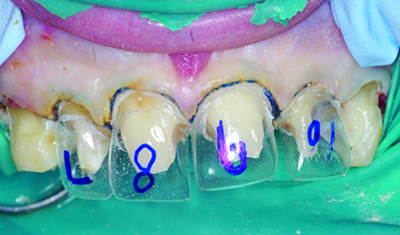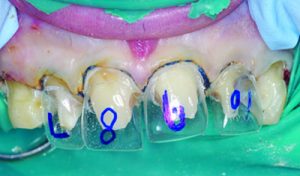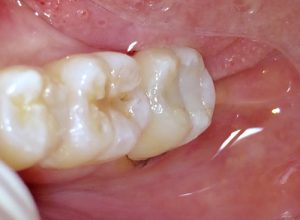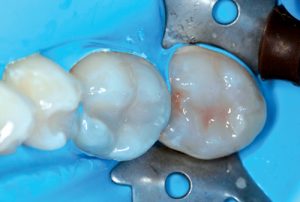Pulpdent ACTIVA BioACTIVE– Not Just Another Composite
Promotional FeaturesPosted by: manpreet.boora 25th October 2017

Learning Objectives
Upon completing this CPD article, the reader will learn that:
- A new BioACTIVE restorative material mimics both the chemical and physical properties of teeth providing additional benefits.
- The flow of the BioACTIVE restorative material means it can be used quickly and easily in tooth restoration making multiple restorations possible at one appointment.
- The new BioACTIVE restorative material interacts with saliva and tooth structure and reacts to changes in the oral environment, contributing to the maintenance of oral health.
- A rubberised resin component absorbs shock and stress and resists fracture and chipping.
- By blending in with the natural colour of teeth and resisting marginal discolouration over time, the BioACTIVE restorative material provides an aesthetic alternative to existing composites.
CASE STUDY 1: Autism, caries and strip crowns
Daniel, a 19-year-old with severe autism, lack of speech, and a seizure disorder, presented at the surgery of Dr. Raymond Kimsey with severe caries. Discussions with his mother revealed that his diet included a lot of apple juice.
Daniel was uncooperative and had no ability to communicate, so Dr. Kimsey knew that treatment needed to be completed quickly and in one visit. With this in mind, Dr. Kimsey took an upper anterior alginate impression at the initial consultation in order to prepare and trim four strip crowns for fitting at the scheduled appointment.

Fig 1: Strip crowns were prepared in advance using a study model. The strip crowns were filled with ACTIVA BioACTIVE-RESTORATIVE, placed, and light cured.
On treatment day, Daniel was sedated through an IV, giving Dr. Kimsey a limited amount of time to work. Although the caries was deep, there were no pulpal exposures. Dr. Kimsey removed the decay, treated the dentine with Pulpdent desensitiser, and fitted the strip crowns filled with ACTIVA BioACTIVE-RESTORATIVE composite (Fig 1)
Dr. Kimsey chose ACTIVA™ BioACTIVE-RESTORATIVE because:
- He could restore multiple teeth in a short period of time.
- The material withstands stress.
- It is an affordable solution.
- The bioactive properties and marginal integrity are more resistant to recurrent caries.
- It flows nicely making it easy to fill and apply strip crowns.
- It is durable and aesthetic.
- It is high-strength and dual-cure.
CASE STUDY 2: The Open Sandwich Technique
Dr. Robert Ho’s male patient was seeking treatment of a distogingival carious lesion and leaking occlusal filling close to the pulp on his lower left second molar. In addition, the patient was suffering some bone loss.
To restore the tooth effectively, Dr. Ho would need to seal the distogingival margin that lacked enamel prior to bonding.
He ruled out placing a crown, as subgingival biological width requirements would be breached in obtaining an accurate impression of the crown margins. Dr. Ho also ruled out amalgam as it is not a bioactive material and is not capable of interacting with saliva to recharge itself and protect the tooth. Glass ionomers were also discounted as they are the weakest of the permanent restorative materials and tend to wash out over time.
Following discussions with the patient about treatment options, Dr. Ho used ACTIVA™ BioACTIVE-BASE/LINER in an open sandwich technique with both ACTIVA™ and the composite exposed to the oral environment.
Having first isolated the tooth using the Isolite system, Dr. Ho removed the decay and applied a sodium diamine fluoride antimicrobial solution. He then used ACTIVA™ BioACTIVE-BASE/LINER on the pulpal floor and as the definitive restorative material along the entire distogingival margin up to the level of the pulpal floor. After curing, he applied phosphoric acid etchant and a bonding agent, placing a nano-composite occlusally as a permanent restoration.

Fig 2: Post-operative photo
Mild sensitivity had improved within a few days, and Dr. Ho was pleased to observe that, at a 10-month recall, a bite-wing image showed the restoration and marginal seal were completely intact (Fig 2).
Dr. Ho decided upon ACTIVA™ BioACTIVE because:
- It is a bioactive material.
- It is moisture friendly and interacts with saliva.
- It protects the tooth.
- It is strong and durable.
CASE STUDY 3: Nine restorations in a single appointment
A female in her early 60s presented at Dr. Barquero’s practice needing dental restorations on nine posterior teeth prior to undergoing radiation treatment for skin cancer.
A typical side-effect of radiation is xerostomia, which can contribute to further tooth decay. Treatment was therefore needed to promote remineralisation and to help protect teeth that were already compromised. ACTIVA™ BioACTIVE-RESTORATIVE was selected, primarily for its ability to promote remineralisation.
First, the enamel was etched for 20 seconds with phosphoric acid etchant, and
although not always necessary when using ACTIVA™ BioACTIVE but rather the clinician’s personal preference, a universal adhesive was applied.

Fig 3: final posterior restorations with ACTIVA BioACTIVE-RESTORATIVE.
ACTIVA BioACTIVE-RESTORATIVE was then placed. Each restoration was completed in eight minutes, following placement of rubber dam, so all nine restorations were achieved in one visit (Fig 3).
ACTIVA BioACTIVE participates in an ionic exchange that is pH-sensitive and supersaturates the saliva and pellicle during low pH cycles. As the pH rises, these minerals are available to form a layer of apatite on the tooth surface, supporting the natural mineralisation process.
Dr. Barquero chose ACTIVA BioACTIVE because:
- The flow facilitates working quickly and efficiently.
- The application produces no bubbles or voids.
- The results are aesthetic.
- The product releases and recharges fluoride, calcium and phosphate ions.
- Its rubberised resin component resists fracture and chipping, making it strong and durable.
- It has dual-cure capability – no concerns about the depth of the cure in deep cavities.
- It supports the natural mineralisation process.
The product keeps margins intact with apatite formation at the material tooth interface and creates a non-soluble seal.
To complete this article and gain one hour of verifiable CPD, https://the-probe.co.uk/courses/course_category/brush-up








